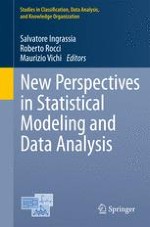2011 | Buch
New Perspectives in Statistical Modeling and Data Analysis
Proceedings of the 7th Conference of the Classification and Data Analysis Group of the Italian Statistical Society, Catania, September 9 - 11, 2009
herausgegeben von: Salvatore Ingrassia, Roberto Rocci, Maurizio Vichi
Verlag: Springer Berlin Heidelberg
Buchreihe : Studies in Classification, Data Analysis, and Knowledge Organization
